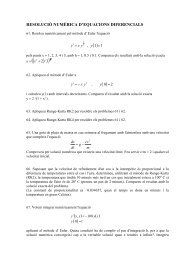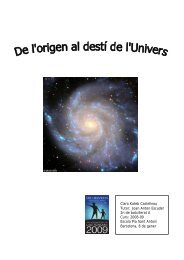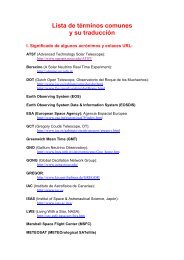Universitat de - Departament d'Astronomia i Meteorologia ...
Universitat de - Departament d'Astronomia i Meteorologia ...
Universitat de - Departament d'Astronomia i Meteorologia ...
You also want an ePaper? Increase the reach of your titles
YUMPU automatically turns print PDFs into web optimized ePapers that Google loves.
1.1. X-ray binaries 9<br />
of an accretion disk close to the compact object, a magnetic field in the accretion<br />
disk, a high spin for the compact object, etc. However there is no clear agreement<br />
on what mechanism is exactly at work.<br />
Among high mass REXBs we find very different types of donors, such as Be,<br />
B[e], SG and Wolf Rayet stars, as well as systems that do not fit in the standard<br />
categories. Among low mass REXBs we find all six Z sources, five Atoll sources, two<br />
persistent sources near the Galactic center and a large number of transient sources.<br />
As quoted in Tables 1.1 and 1.2, there are around 8 radio emitting HMXBs and<br />
35 radio emitting LMXBs. The corresponding abundances are ∼ 6% and ∼ 23%,<br />
respectively. There is a significant difference between those values. However, the<br />
sources located in the Large and Small Magellanic Clouds, at ∼ 50 kpc and ∼ 58 kpc,<br />
respectively, are around 5 times farther than the most distant galactic REXBs,<br />
and the flux <strong>de</strong>nsity of those sources in quiescence is expected to be ∼ 25 times<br />
lower, preventing any radio <strong>de</strong>tection up to now. If we exclu<strong>de</strong> these sources, then<br />
the abundances change into ∼ 9% and ∼ 24%, respectively. Moreover, since the<br />
strong magnetic field X-ray pulsars disrupt the accretion disk at several thousand<br />
kilometers from the neutron star, there is no inner accretion disk to launch a jet<br />
in these systems, and no synchrotron radio emission has ever been <strong>de</strong>tected in any<br />
of those sources. Hence, consi<strong>de</strong>ring only the galactic HMXBs and LMXBs and<br />
excluding XPs, the previous numbers change into ∼ 22% and ∼ 24%, respectively,<br />
which are in<strong>de</strong>ed quite similar. As pointed out by several authors and as we have<br />
seen, although the division of X-ray binaries in HMXBs and LMXBs is useful for<br />
the study of binary evolution, it is probably not important for the study of the<br />
radio emission in these systems, where the only important aspect seems to be the<br />
presence of an inner accretion disk capable of producing radio jets. However, the 8<br />
radio emitting HMXBs inclu<strong>de</strong> 6 persistent sources and 2 transient sources, while<br />
among the 35 radio emitting LMXBs we find 11 persistent sources and 24 transient<br />
sources. It is clear that the difference between the persistent and transient behavior<br />
highly <strong>de</strong>pends on the mass of the donor.<br />
In any case we can say that, excluding X-ray pulsars, 20 to 25% of the catalogued<br />
galactic X-ray binaries have been <strong>de</strong>tected at radio wavelengths, regardless of the<br />
nature of the donor. The corresponding ratio of <strong>de</strong>tected/observed sources is proba-<br />
bly much higher. However, it is difficult to give reliable numbers, since observational<br />
constrains arise when consi<strong>de</strong>ring transient sources observed in the past (large X-ray






